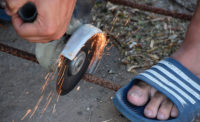Here are some of the most common safety practices that don’t work, and what to do instead.
Focusing on lagging indicators
Incident rate, lost time rate, severity rate and other lagging indicators are poor measures of safety. Such measures tell us how many people got hurt and how badly but do not tell us how well a company is doing at preventing accidents and incidents. One reason they are a poor gauge of prevention is that these numbers have what statisticians call natural variation. In other words, it is a statistical fact that if the yearly number of unsafe conditions and unsafe behaviors were held constant, an organization could experience a different number of incidents during the first half of a year and the last half (or from one year to the next). Thus, incident rate can get better or get worse with absolutely no change in safety conditions or behaviors. The result is that organizations, and departments within organizations, can go for long periods of time without accidents, despite having an unsafe work environment.
By the very nature of it, this statistical fact works against keeping safety a priority. Furthermore, such lagging metrics result in reactive safety management where incidents lead to a flurry of activity, but during periods with no incidents, safety is given a low priority. A better approach is to manage safety with leading indicators that focus on proactive activities on the part of all employees — measures that track what people are doing daily to prevent accidents, while keeping a quiet eye on lagging indicators.
Injury-based incentive programs
Having zero incidents is the ultimate goal of safety, but most safety incentive systems are fundamentally flawed. The problem is that the employees can get the incentives in three possible ways:
1. Employees work safely and thus earn the reward. In this case the incentives are operating as intended; they are motivating safe behavior and that safe behavior is preventing accidents.
2. Employees engage in at-risk behaviors but are lucky in that none of the at-risk behaviors result in an accident. In this case the incentives are rewarding luck and possibly teaching employees that at-risk behaviors are OK.
3. Employees engage in at-risk behaviors and some of those at-risk behaviors result in accidents, but the accidents are not reported in order to avoid losing the incentive. In this case, incentives are motivating non-reporting of accidents.
To avoid these problems and ensure improved safety, motivational systems should be based on preventive measures. Identify what employees at all levels need to do day to day and week to week to prevent incidents and establish meaningful consequences for those behaviors. A system that reinforces safe behaviors directly linked to desired results will get more people engaged in preventive behaviors, which will naturally reduce your incident rate.
Punishing people who make mistakes
Human error is inevitable. The key to reducing it is a better understanding of why it happens. When organizations use negative consequences in response to at-risk behaviors, near misses and incidents, it creates an environment of finger-pointing and cover-ups rather than an environment of learning from mistakes. While there is a place for all consequences in safety, including negative consequences like discipline, care must be taken. Much research has been done on the use of negative consequences and the findings would surprise many. While discipline can be effective, it is remarkably hard to execute well and has side effects that are of grave concern in safety. Most organizations don’t think they overuse discipline; however this must be assessed relative to the use of positive consequences. Too often frontline employees report that they only hear about safety when they have done something wrong. In the context of little positive reinforcement for safe behavior, even small amounts of discipline can lead to the same side effects as heavy-handed use of discipline.
Side effects include lower morale, decreased teamwork, decreased volunteerism, lower trust and suppressed reporting of incidents and near misses. The last one is critical. If employees believe that what they report around safety may be used against them, they are likely to stay quiet. They will not discuss safety concerns, they will not report near misses, they will not report incidents (if they can get away with it) out of fear of reprisal. Incidents, near misses and at-risk behaviors all provide valuable opportunities to learn how to make the workplace safer. Discipline, reprimands and other forms of punishment stifle reporting and make achieving a culture of safety impossible. To be clear, we are not saying there is no place for discipline (or other negative consequences); however the science demonstrates that in the vast majority of cases, unsafe behavior can be turned into safe behavior without the use of discipline and all its undesirable side effects. It is far more productive to focus on prevention and create a system of positive accountability for preventive activities.
Relying on training and safety signage for sustained improvement
Behavior is influenced by two things: antecedents, which come before behavior and prompt it, and consequences, which come after behavior and either strengthen or weaken it. The science is clear: antecedents are necessary, but not sufficient for lasting improvement. Consequences are what drive improvement. Despite this scientific fact, many of the tools used in safety fall into the category of antecedents.
Training provides the perfect example. Predictably, the most common outcome of safety training is a temporary change in behavior followed by a gradual return to old habits. The problem is not that people don’t care or don’t want to change. The problem is that training is only an antecedent and does little to affect the consequences in the workplace where the behavior occurs. Training will get behavior started but that behavior must then be reinforced in the workplace. Once you understand behavior from a scientific perspective, you can see that the analysis and adjustment of the consequences for target behaviors is where long-term solutions lie.
Safety signage provides another example. Any employee will tell you that most safety signs don’t change their behavior. In particular, inspirational signs like “Think Safety” or “Be Alert, Don’t Get Hurt” do little or nothing to impact safety. Furthermore, when organizations clutter their walls with signs that have no meaningful information, employees are more likely to ignore important signage. In order to maximize effectiveness, use only compliance signs that direct specific behavior (“Hearing protection required in this area”) and informational signs when appropriate and relevant.
Scientific analysis of safety practices helps leaders to let go of outdated, low-impact strategies and replace them with evidence-based practices that create a safer workplace.




